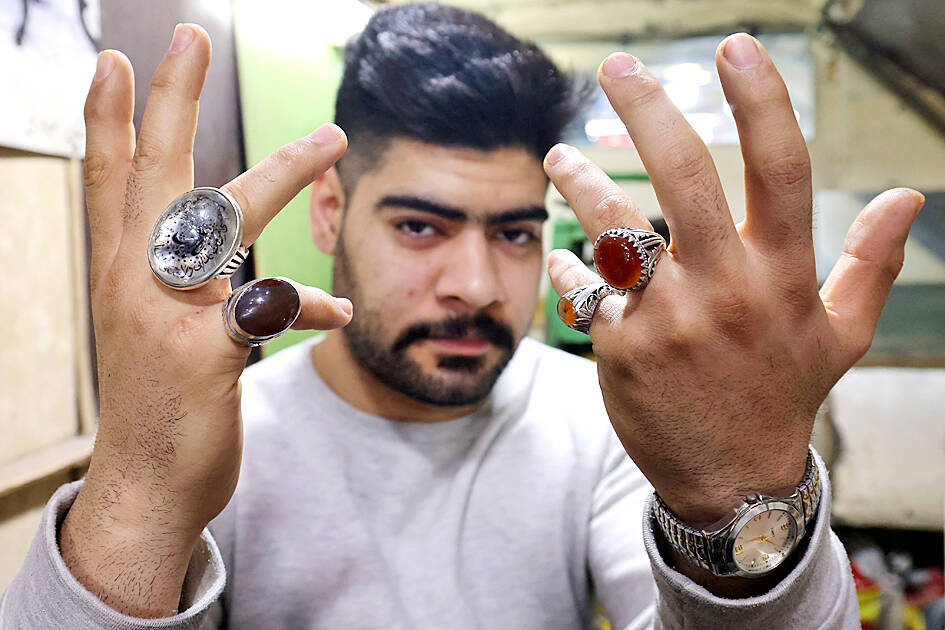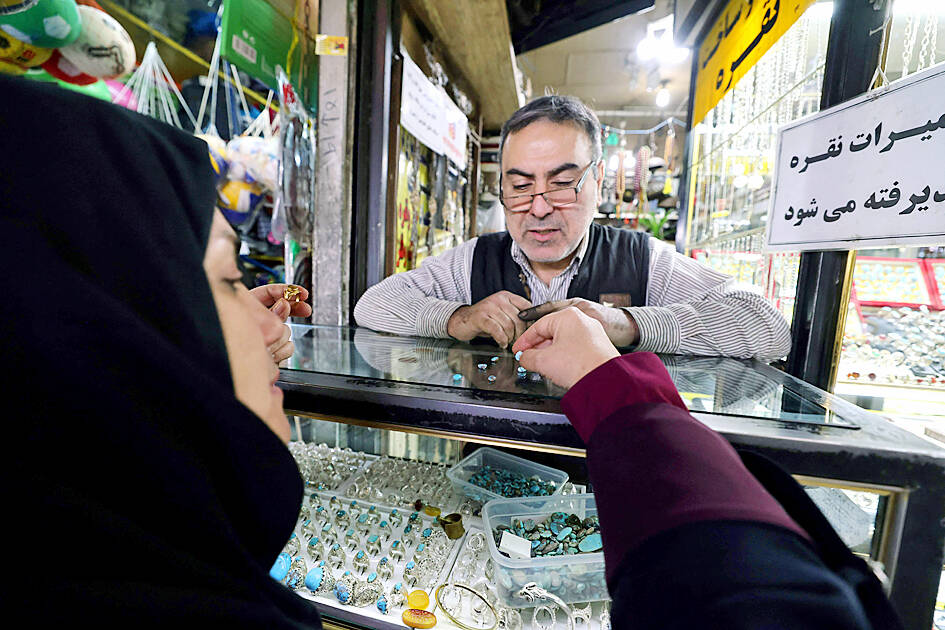At a prominent Shiite shrine in southern Tehran, Qasem Ashgari was buying yet another gemstone ring in the hope it would help his prayers to be answered promptly.
Asghari, in his 30s, who was already wearing several bands on each hand, had a specific ring in mind: a silver one, adorned with yellow agate and engraved with religious scripts.
“The reward of one prayer is multiplied ... if done with an agate ring,” he said, while strolling through the meandering alleys of the market near Shah Abdol-Azim Shrine.

Photo: AFP
Asghari’s appreciation for gemstones is shared by many Shiite Muslims in Iran, where prominent male academics and senior officials often publicly sport similar rings.
Many in the Shiite-majority country attribute high religious significance to gemstones, which they view as a way to ensure divine protection, ward off evil and prevent poverty.
Common beliefs associated with gemstones are largely what motivates people to buy them, said Hassan Samimi, a lapidary at the market.

Photo: AFP
“It is very rare to find someone who wears a ring just for its beauty,” Samimi, 52, said, in his workshop where he carves large uncut gemstones for rings, necklaces, prayer beads and other items.
Inside, one customer, Maryam, browsed through a collection of rings bearing agate, turquoise, topaz, lapis lazuli, emeralds and other stones.
“I get a good feeling from these stones,” the 50-year-old teacher said, after picking a turquoise set comprising a ring, earrings and a bracelet.
Samimi said his sales were mostly from agate and turquoise, the most revered stones, especially among Iran’s religious community.
Turquoise has been mined in the country since the times of ancient Persia, with Iran home to one of the oldest such mines in the world.
Its bluish-green color has inspired artists over the years and features prominently in Persian monuments and artifacts as well as Islamic architecture.
The turquoise from the eastern city of Neyshabur “is the most expensive,” Samimi said. “The smoother and bluer the turquoise is, the higher its price is.”
Hamid Rashidi, another craftsman, said the stone is generally affordable, but depending on the quality a piece could sell for as much as 4 billion rials (US$95,125).
Many Iranians believe it attracts wealth to the bearer and sometimes cite the religious saying “the hand that wears turquoise... will never see poverty.”
It is also believed “to enhance eyesight and calm the nerves,” Samimi said.
Agate, especially from Yemen, is also popular “because it is recommended by imams” who often claim it can boost livelihoods, Rashidi said.
Senior officials including Iranian Supreme Leader Ayatollah Ali Khamenei have often been spotted wearing rings with agate or turquoise stones, and he has been known to gift them as tokens of his appreciation.
The body of the revered Iranian Revolutionary Guards Corps commander general Qasem Soleimani, who was killed in a 2020 US strike in Baghdad, was in part identified by the agate ring he wore.
Iran subsequently declared the ring “cultural heritage” and a “national asset.”
Demand for gemstones has remained relatively steady despite Iran’s severe economic challenges, Samimi said.
Inflation in the country has in the past few years hovered near 50 percent, while the rial has sharply declined against the dollar.
“The stones market has become much better” over the years, he said, adding that there had been a significant increase in the number of craftsmen in the market compared with nearly three decades ago.
Its continued success might hang on evolving tastes.
Samimi said that agate and turquoise are not popular among younger generations.
“Young people mostly buy rubies and emeralds and birthstones,” he said. “For them, they are more fashionable.”

The New Taiwan dollar is on the verge of overtaking the yuan as Asia’s best carry-trade target given its lower risk of interest-rate and currency volatility. A strategy of borrowing the New Taiwan dollar to invest in higher-yielding alternatives has generated the second-highest return over the past month among Asian currencies behind the yuan, based on the Sharpe ratio that measures risk-adjusted relative returns. The New Taiwan dollar may soon replace its Chinese peer as the region’s favored carry trade tool, analysts say, citing Beijing’s efforts to support the yuan that can create wild swings in borrowing costs. In contrast,

Nvidia Corp’s demand for advanced packaging from Taiwan Semiconductor Manufacturing Co (TSMC, 台積電) remains strong though the kind of technology it needs is changing, Nvidia CEO Jensen Huang (黃仁勳) said yesterday, after he was asked whether the company was cutting orders. Nvidia’s most advanced artificial intelligence (AI) chip, Blackwell, consists of multiple chips glued together using a complex chip-on-wafer-on-substrate (CoWoS) advanced packaging technology offered by TSMC, Nvidia’s main contract chipmaker. “As we move into Blackwell, we will use largely CoWoS-L. Of course, we’re still manufacturing Hopper, and Hopper will use CowoS-S. We will also transition the CoWoS-S capacity to CoWos-L,” Huang said

Nvidia Corp CEO Jensen Huang (黃仁勳) is expected to miss the inauguration of US president-elect Donald Trump on Monday, bucking a trend among high-profile US technology leaders. Huang is visiting East Asia this week, as he typically does around the time of the Lunar New Year, a person familiar with the situation said. He has never previously attended a US presidential inauguration, said the person, who asked not to be identified, because the plans have not been announced. That makes Nvidia an exception among the most valuable technology companies, most of which are sending cofounders or CEOs to the event. That includes

INDUSTRY LEADER: TSMC aims to continue outperforming the industry’s growth and makes 2025 another strong growth year, chairman and CEO C.C. Wei says Taiwan Semiconductor Manufacturing Co (TSMC, 台積電), a major chip supplier to Nvidia Corp and Apple Inc, yesterday said it aims to grow revenue by about 25 percent this year, driven by robust demand for artificial intelligence (AI) chips. That means TSMC would continue to outpace the foundry industry’s 10 percent annual growth this year based on the chipmaker’s estimate. The chipmaker expects revenue from AI-related chips to double this year, extending a three-fold increase last year. The growth would quicken over the next five years at a compound annual growth rate of 45 percent, fueled by strong demand for the high-performance computing